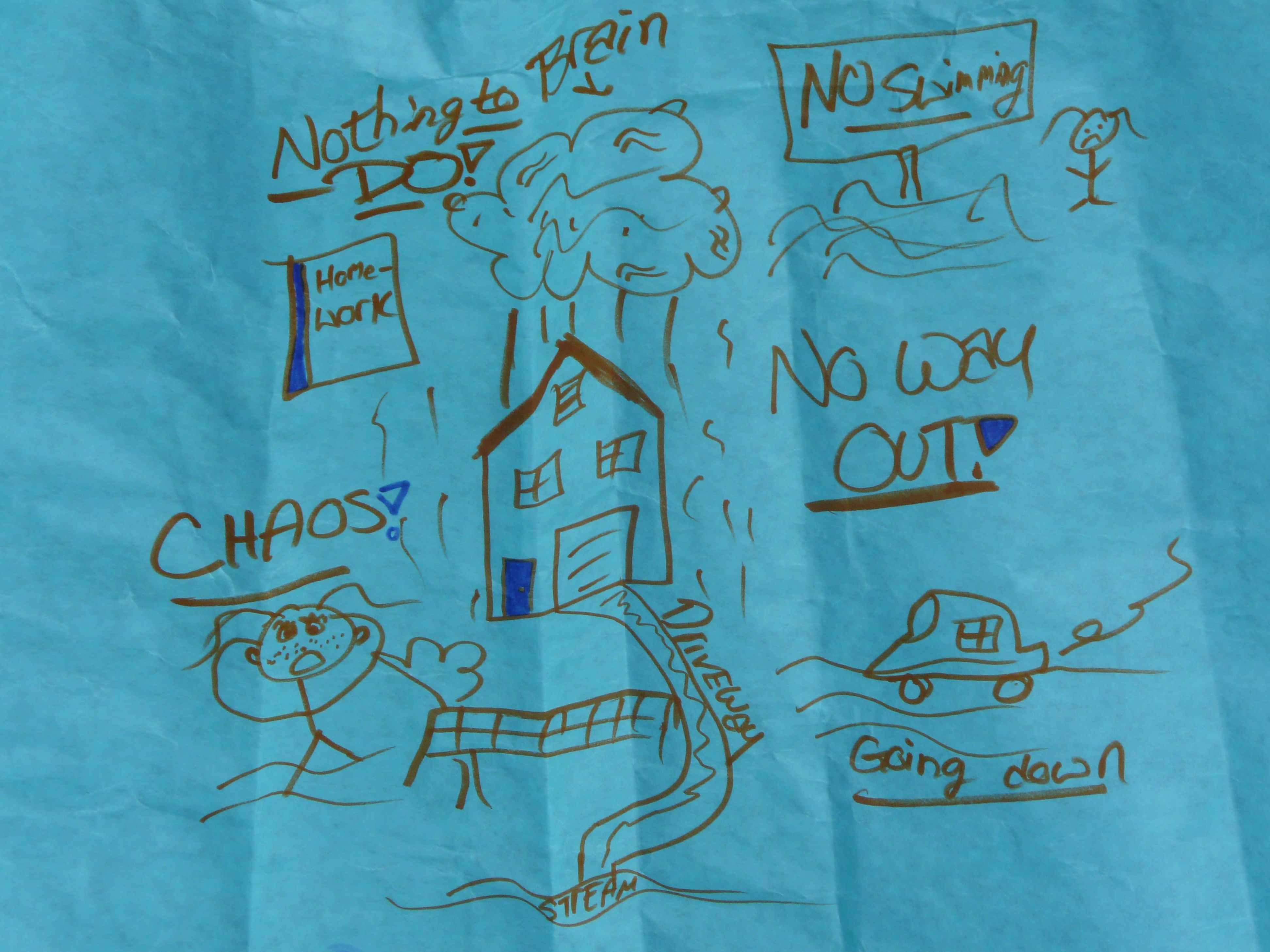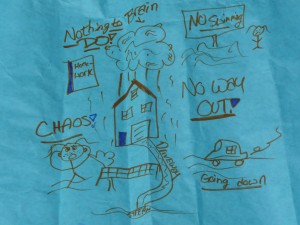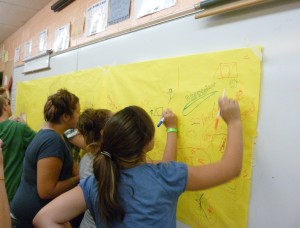
Oct 07, 2011 Graffiti Wall Activity: Middle School Students Reflect on Tropical Storm Irene
Today I am returning to the blog after a few weeks offline due to Tropical Storm Irene.
 Our little village of Brookside in South Newfane, Vermont and many neighboring towns were hit hard by flooding during Irene. Some of our neighbors lost their homes. Power, phone and Internet were gone for many days and our roads are still being rebuilt. Though the damage to homes and infrastructure and the sorry state of our rivers and roads is hard to take, we are very thankful to be part of such a wonderful community and proud to be living in Vermont. This kind of event often forces people to reflect on what is truly important in life and neighbors find themselves serving their community in ways they didn’t have “time” for before and relying on those around them. The moments of reflection and of neighbor helping neighbor have been as impressive and uplifting as the storm was devastating.
Our little village of Brookside in South Newfane, Vermont and many neighboring towns were hit hard by flooding during Irene. Some of our neighbors lost their homes. Power, phone and Internet were gone for many days and our roads are still being rebuilt. Though the damage to homes and infrastructure and the sorry state of our rivers and roads is hard to take, we are very thankful to be part of such a wonderful community and proud to be living in Vermont. This kind of event often forces people to reflect on what is truly important in life and neighbors find themselves serving their community in ways they didn’t have “time” for before and relying on those around them. The moments of reflection and of neighbor helping neighbor have been as impressive and uplifting as the storm was devastating.
I experienced one of these positive moments during a “back to school” team-building session with students at Twin Valley Middle School (TVMS) in Whitingham, VT. I was scheduled to “kick-off” the school year with community building activities the first week of school. When Irene wreaked havoc on our community, school started a week late. When I arrived to work with students after the delayed start it seemed important to reflect on the flood, and the unusual start to the year along with the excitement, anticipation and stress that comes as a normal part of the beginning of middle school. I engaged students in a reflective activity called “Graffiti Wall” that I learned from Kasey Errico an educator who attended my workshop at the Association for Experiential Education conference last spring.
 I taped large lengths of butcher paper on the walls. As students entered the classroom I had them choose their favorite color marker. I set up the activity by asking them to imagine that they are graffiti artists and that this is their can of spray paint. They have been given permission by a store owner to decorate the wall with graffiti to describe their experiences, thoughts, reflections, questions regarding the flood, what it has been like starting school amidst the recovery, the late start to the school year and what it is like to be an 8th grader. I asked them to use artwork or words and explained that like a real wall of graffiti others can add to or comment on their artwork or musings. I encouraged them to do this silently (probably an unrealistic challenge for middle schoolers, but something that has been helpful when I have facilitated this activity with older groups).
I taped large lengths of butcher paper on the walls. As students entered the classroom I had them choose their favorite color marker. I set up the activity by asking them to imagine that they are graffiti artists and that this is their can of spray paint. They have been given permission by a store owner to decorate the wall with graffiti to describe their experiences, thoughts, reflections, questions regarding the flood, what it has been like starting school amidst the recovery, the late start to the school year and what it is like to be an 8th grader. I asked them to use artwork or words and explained that like a real wall of graffiti others can add to or comment on their artwork or musings. I encouraged them to do this silently (probably an unrealistic challenge for middle schoolers, but something that has been helpful when I have facilitated this activity with older groups).
The activity jumpstarted a meaningful reflective discussion. A few students lost their homes and family businesses and many parents are out of work due to the businesses in Wilmington, VT being destroyed by this record flood. One student who lives downtown shared that she had been keeping a list of all the items that floated by her house.
 What emerged from the discussion following the graffiti activity was the increased sense of compassion and understanding students have gained through the flood experience. EVERY 8th grade student shared an example of service they had offered the community during the crisis including babysitting at the red cross center so that their parents could help clean out homes and businesses, working at the food bank, shoveling mud from basements, or sheltering neighbors in their homes.
What emerged from the discussion following the graffiti activity was the increased sense of compassion and understanding students have gained through the flood experience. EVERY 8th grade student shared an example of service they had offered the community during the crisis including babysitting at the red cross center so that their parents could help clean out homes and businesses, working at the food bank, shoveling mud from basements, or sheltering neighbors in their homes.
Since Kasey introduced me to this activity last spring I have used the graffiti activity a number of times with positive outcomes. I like the blend of self-reflection and group collaboration. Often people will more readily express their thoughts through artwork than verbal means. It is non-intimidating to those who don’t consider themselves “artists” because they can blend words and images. Group members can choose their level of participation and learn as much from contributing as they do from observing other’s posts. The graffiti becomes an “artifact” of the group’s thoughts and experiences and can jumpstart meaningful dialogue and reflection.
In past posts I have encouraged educators to think of reflective practice as an ongoing part of their programs rather than something that happens at the end as a “debrief”. This is a great example of a reflection activity that can be used at the beginning, middle or end of a group experience.



No Comments